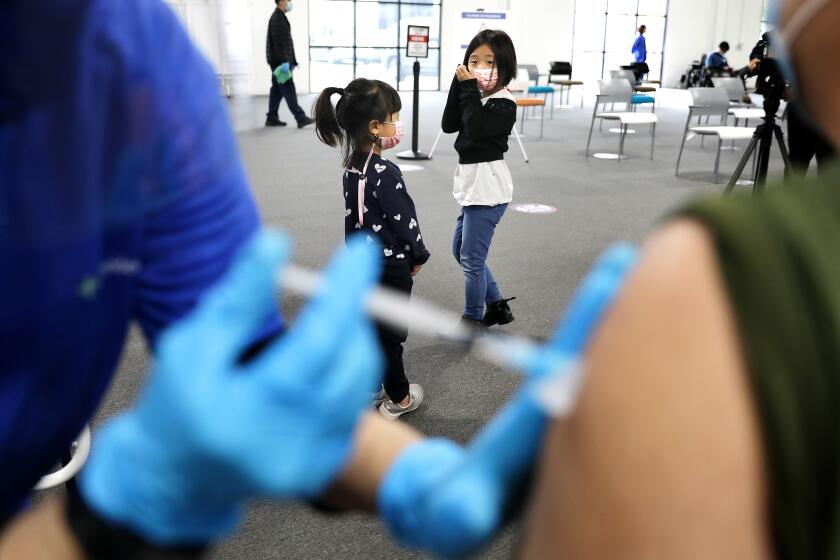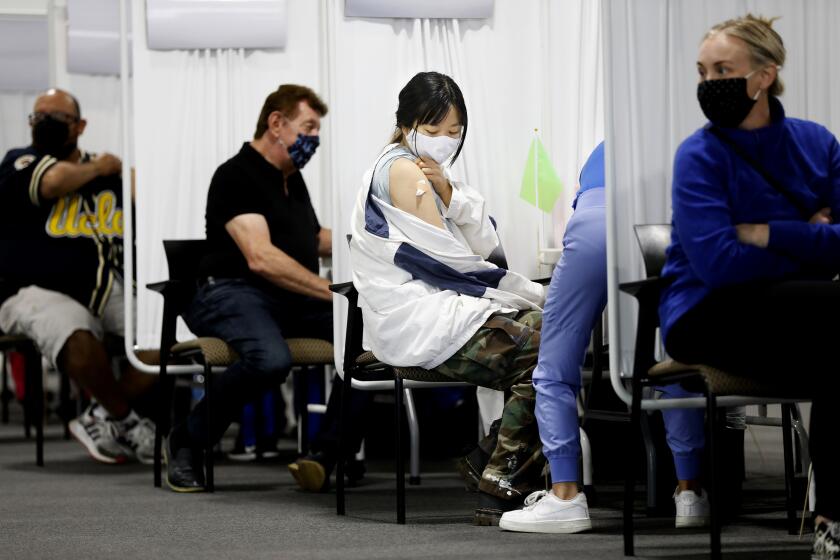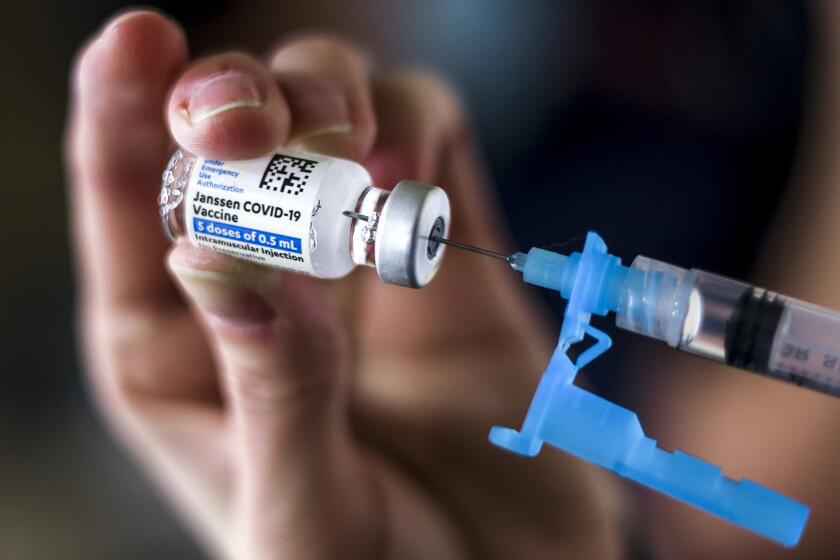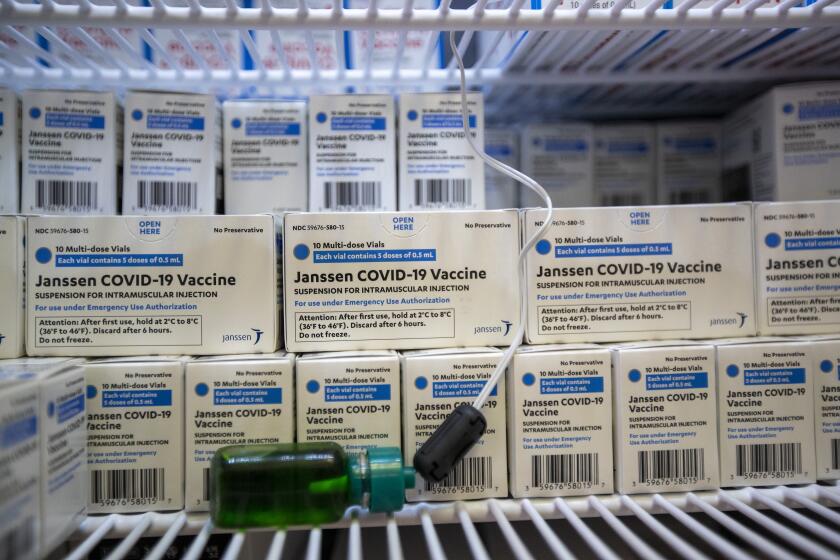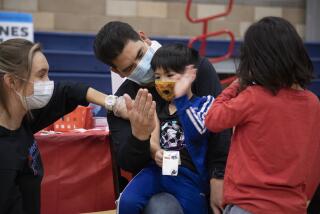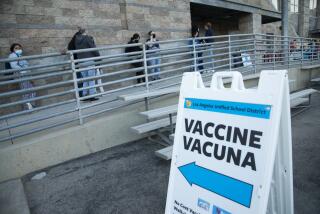California’s COVID-19 vaccination pace slowed after Johnson & Johnson pause, data show
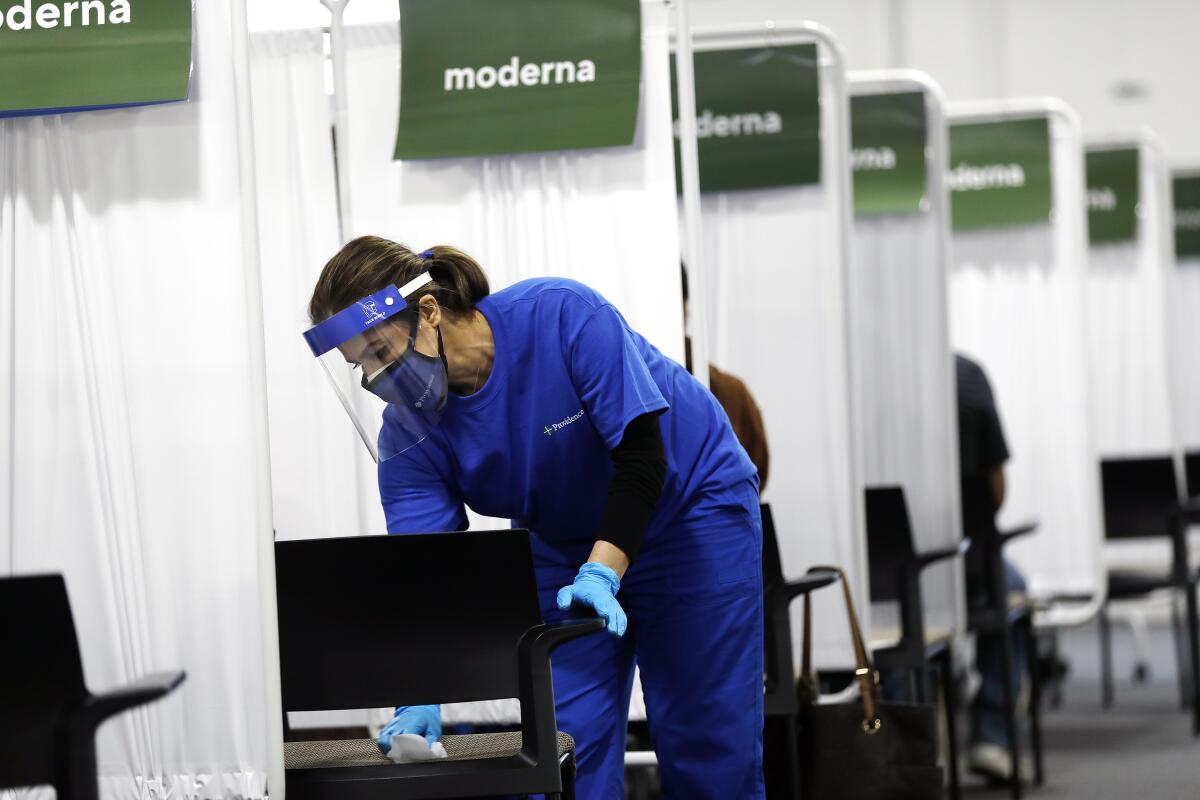
- Share via
California’s COVID-19 inoculation pace tailed off after officials paused use of the Johnson & Johnson vaccine as a precaution earlier this month, according to data compiled by The Times.
With that stoppage now lifted, it remains to be seen whether the state will reverse the recent blip before it morphs into a more downward trend.
Over the weeklong period ending Friday, providers throughout California doled out an average of 329,483 vaccine doses per day. That’s down about 16% from the statewide peak of 394,326, which was recorded two days before federal officials called for a halt in administering Johnson & Johnson vaccines following reports of a rare clotting disorder among a handful of recipients.
Although there’s a natural lag in California’s vaccine reporting, as it takes time to account for all the doses administered on a particular day, every day last week saw fewer new doses administered than the corresponding day the week before, and Friday’s rolling average was the lowest since the end of March, Times data show.
That’s despite the fact that California opened vaccine eligibility to everyone 16 and older starting April 15.
It’s not surprising that the pause would create short-term disruptions. Discontinuing use of the Johnson & Johnson vaccine effectively dammed up one of the supply streams available to the state — temporarily reducing the number of doses available and forcing providers to shuffle their operations to fill gaps.
The city of Los Angeles, for instance, had to hold on to 29,000 doses of Johnson & Johnson during the 10-day pause.
“To end this pandemic, we need to use every dose we have — and the Johnson & Johnson vaccine is a critical piece of that strategy,” Mayor Eric Garcetti said in a statement Sunday.
The week of April 5, California’s direct federal allocation of Johnson & Johnson was 572,700 doses, according to data from the Centers for Disease Control and Prevention. That number plummeted to 67,600 the next week and dried up completely the week after the pause.
However, increases in shipments of the other two available vaccines, Pfizer-BioNTech and Moderna, have helped offset the loss somewhat.
Encouraging statistics have buoyed hopes that authorities can vaccinate enough people at a sufficient speed to head off a potential variant-driven surge.
What’s unclear at this point is whether there’s the same public appetite for vaccines as there was in the earlier days of the rollout — when snagging an appointment often took a lot of effort and more than a little luck.
Spots for this week are still open in Los Angeles County, and officials said a limited number of walk-up slots would be available through Thursday at county-run mass vaccination sites.
L.A. County Public Health Director Barbara Ferrer said it was “really easy to get vaccinations now” and that, with walk-in availability, residents didn’t “need to really wait and spend a lot of time trying to find appointments.”
“It’s really important for us to get every single vaccine dose that we have into someone’s arm as quickly as possible,” she said during a briefing Monday.
Over the last week, California has reported an average of 1,901 new cases per day, a 34% decrease from two weeks ago, according to data compiled by The Times.
The CDC lifted the pause on the Johnson & Johnson vaccine Friday. On Saturday, the Western States Scientific Safety Review Workgroup — which includes public health experts from California, Nevada, Oregon and Washington — also recommended resuming use of the vaccine.
Even with the return of the J&J vaccine, it’s possible the temporary embargo could dissuade some from getting that shot, a potential sticking point that authorities are already working against.
The pause was precautionary, officials emphasize, and the disorder that prompted it has been detected in just 15 patients since the J&J vaccine rolled out March 2.
Despite reopening gains, experts think herd immunity is a ways off, and they say several factors will keep COVID-19 a fact of life for some time.
To date, more than 8 million Americans — and nearly 1.1 million Californians — have received that vaccine, CDC data show.
Officials have long hoped that the rollout of the Johnson & Johnson vaccine would give inoculation efforts a shot in the arm.
Because that vaccine requires only one dose — compared with the two, administered weeks apart, necessary for both Pfizer-BioNTech and Moderna — it’s possible to fully vaccinate people at a much quicker rate.
Only needing one dose also makes Johnson & Johnson an attractive option for harder-to-reach populations, including those who are homebound or homeless, or who don’t have the time to attend two vaccine appointments.
Ferrer said nearly 278,000 people who had received a first dose in L.A. County were currently overdue for their second shot. The recommended interval between doses is three weeks for Pfizer-BioNTech and four weeks for Moderna.
The reasons for that vary. Some people may have simply forgotten about or been unable to make it to their follow-up appointment, or experienced unpleasant side effects from their first shot that made them uneasy about rolling up their sleeves again.
Others may have received their first dose outside L.A. County and be confused as to where to go for their second shot.
And still more may simply feel like they don’t need both doses.
Though it’s true that “one dose does offer some protection” against COVID-19, “it’s not as strong a level of protection as what two doses offer,” Ferrer said.
A CDC advisory panel is grappling with the best way to “do no harm” regarding Johnson & Johnson’s COVID-19 vaccine and its risk of blood clots.
If anything, Ferrer said she thought the temporary halt should help allay concerns surrounding Johnson & Johnson.
“We’re lucky that we live in a nation that has a very robust safety program in place so that on an ongoing basis as more and more people are using, in this case a vaccine, we’re able to continually assess for any safety concerns. And that’s what happened with this pause,” she said during a recent briefing.
But she acknowledged that the decision might ultimately put some people off.
“I do know for some people, it is frightening to think that there could be some side effects from a vaccination that we are asking people to consider using because it’s going to ultimately save so many lives,” she said. “We just hope that people have confidence in the system that’s in place.”
Los Angeles County is ready to again administer the Johnson & Johnson COVID-19 vaccine after federal health agencies on Friday lifted the pause that’s kept those doses in limbo for more than a week.
Among those who have received the Johnson & Johnson vaccine in California are a number of high-ranking state officials — including Dr. Mark Ghaly, secretary of the California Health and Human Services Agency; the director of the state Department of Public Health and state health officer, Dr. Tomás Aragón; the California surgeon general, Dr. Nadine Burke-Harris; the state epidemiologist, Dr. Erica Pan; and Gov. Gavin Newsom.
“I encourage all Californians to trust the science,” Newsom said in a statement. “Getting vaccinated is the best way to protect ourselves and our loved ones and end the pandemic.”
Times staff writers Melissa Healy and Alex Wigglesworth contributed to this report.
More to Read
Sign up for Essential California
The most important California stories and recommendations in your inbox every morning.
You may occasionally receive promotional content from the Los Angeles Times.

